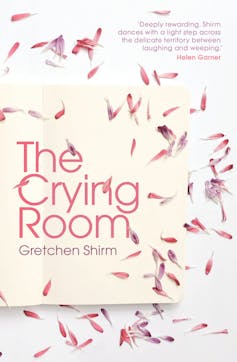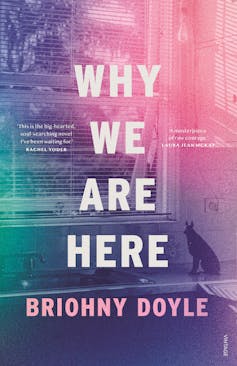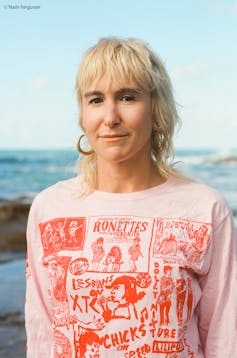
Gretchen Shirm’s The Crying Room and Briohny Doyle’s Why We Are Here share a preoccupation with death and grief and what it means to live on, without intimate others, during a climate crisis. Both novels feature protagonists who lose parents and partners, and both explore their themes via writer-narrators who are producing fictions.
Review: The Crying Room – Gretchen Shirm (Transit Lounge); Why We Are Here – Briohny Doyle (Vintage)
Shirm’s book takes the form of a series of interlinked stories. We are introduced to the concept of the “crying room” by Monica, who is writing a story about her aunt Susie, who has played a motherly role in her life.
In the story, Susie is employed by a crying room where people go to express their emotions. She admires these “criers”, who labour in the dark to “make something” out of what they feel:
They reminded Susie of miners in a cave, with a small circle of light above them to illuminate their features. She thought of the clink, clink, clink of sharp metal implements chipping away patiently at cold, dark, stone.
In another story, titled “The Plane that Fell Out of the Sky”, Shirm uses marginal notes that run parallel to the main text to tell us more about Monica’s life as an author. Monica publishes a book that her publisher describes as “elegiac” – though she “didn’t understand where it came from, this pervasive sense of loss”.
Her publisher asks her to change the title:
couldn’t we have some happiness here? […] Not everyone is this sad.
But Monica resists this request, reflecting that it is more challenging to write about happiness:
there was a time component to happiness; it accumulated over months, across years. Sadness on the other hand, and grief – those emotions had their own definition and shape.

The use of Monica as the author of the more surreal parts of the book gives The Crying Room a complex, layered quality. The strategy allows Shirm to experiment with perspective and disrupt realist conventions while exploring the emotional lives of three generations of women.
Monica is at the end of a line of women who are ambivalent about mothering. Her grandmother, Bernie, loved her young daughters intensely but hyper-critically, making them feel uncomfortable with themselves: “withdrawing was a tactic she’d used on them as girls, and only now she saw what it had done.”
Her aunt Susie is a paediatric oncologist, who is unable to have a baby of her own, but believes that she can provide Monica with a better life than her seemingly unsympathetic sister Allison. At 11 years of age, Monica escapes Allison and is taken into the care of her aunt. “Susie had always expected to feel affection towards her; what she hadn’t anticipated was the blind feeling that surged up, the love.”
Susie’s relationship with Monica causes a breach in her relationship with her husband Will, who feels they are co-dependent – especially when Susie spends nights sleeping in Monica’s room to soothe her. When his Malaysian Airlines flight goes down, his loss is felt immediately. Susie spends years mired in grief searching for answers, which eventually leads to an encounter with Will’s “double” in a story called “The Closure Company”.

The story almost certainly draws on the Japanese concept of a rental family service: a professional stand-in service that provides clients with actors who portray friends, family members or co-workers. Susie seeks a stand-in for Will so she can ask him why he left, but she finds the experience more agitating than calming.
The stories “The Crying Room” and “The Closure Company” are ostensibly inventions of Monica the author. But they also speak to Shirm’s interest in accessing emotion through ritual and simulation. Through her writing Monica begins to recognise the patterns running through the matriarchal line of the family, which in turn encourages her to find her way back to her biological mother.
Bernie’s later-life friendship with Narelle, a First Nations woman, educates her in local history and teaches her about children: “you have to let them cry so they know what they feel”. She comes to appreciate the apple tree planted in the empty chicken coop, which she had scoffed at when Susie gave it to her years ago.
The tree, growing against the odds in a hot climate, amid the bones of a long-dead calf, symbolises hope.
Distruped expectations
Briohny Doyle’s Why We Are Here, which might be labelled as autofiction, also disrupts expectations. The novel is narrated by a character named BB after the death of her partner, who is referred to only as “Him” or “He”, possibly to indicate his outsized role in her life.
BB moves to Balboa Bay, a suburb of Silver City (Sydney), after spending part of the pandemic in Highborne (Melbourne), only to be locked down again. She lives in a condemned apartment, with trappings of faded grandeur, making Silver City almost affordable.

At first, she shares the apartment with Franz, a European man who has different taste: he prefers minimalism, while she is enamoured by rich colourful Almodóvarian interiors. When Franz is expelled by the closing of the borders, BB remains alone with her dog Baby and spectral visitations from “Him”.
The relaxed beach lifestyle at Balboa Bay is a stark contrast with BB’s Highborne existence, though it is regularly punctuated by the loudspeaker of the nearby prison. BB imagines these pronouncements are philosophical observations by Simone Weil, whose book Gravity and Grace she reads as a “vision of surrender”.
The dog Baby and BB constant continually “telegraph” to each other. A long passage is devoted to Baby’s telegraphed thoughts about their relationship and the transience of other people through their lives:
You are still here but there are those who are no longer with you. Tall man. Old Man. Upstairs Man. Snack girl […] We have a good thing going this with me. Let’s keep doing with me please I don’t care where as long as breakfast dinner. Now sandwich.
This technique is reminiscent of The Animals In That Country (2020), a novel by Doyle’s contemporary Laura Jean McKay, which forged new ways of writing non-human speech.
To divert herself, BB begins training local dogs during the pandemic pet boom, after her neighbour invites her to train his Doberman who is enraged by golfers shouting “FORE!” on the range next door. She thinks:
perhaps this is the thing I’ve been waiting for. A calling to locate me in space and time.
Although she finds a language to engage with troubled dogs like the Doberman, she’s distrusted by local trainers who see her as competition.
Read more: An unreliable narrator and a stormy relationship propel Stephanie Bishop's moody new novel
Elegy
BB lets us into her thinking about the work that we are reading, providing clues about how to decode it. She has conversations with a friend about what she is attempting:
Maybe what I’m writing isn’t really fiction, anyhow. Maybe it’s elegy. For Him, but also, for everything else.
They decide that elegy is having a moment, but that it’s also “problematic, Judeo-Christian, colonial, or at the very least nostalgic”.
Such interpretations and valuations become a key theme. BB realises that “different deaths read differently”. Some are unsurprising; others are regarded as tragic. When she writes about the deaths of her partner and father, editors tactfully suggest that the circumstances of their deaths need to be explicated, so people can decide how to interpret them. This is necessary for “feeding the trauma economy”, another of BB’s friends tells her.
BB’s partner and father wrestled with addiction and poor mental health, placing them in the category of “regrettable but inevitable outcomes of choice or circumstance”. But in elegy, the way a person dies is not the point.
Stuck in a loop, BB repeatedly imagines His death, and that of her father:
If I had an escape hatch that opened into His last moments in this world, I would jump right in and close it tight behind me. Only sometimes though.

BB comes to understand that the pandemic is experienced differently by people who haven’t been through the deaths of loved ones. Her grief keeps her at a distance from everyone, even her love interests, Vera and Franz: a hot ranger and sexy golfer.
She also sporadically inhabits a “university that turned into a grid of squares”. During her online creative writing classes, she talks to her students about how to make writing work. Through these conversations, we sense BB’s desire to challenge form.
Why We Are Here is not a plot-driven novel. It’s an open-ended, digressive book that tackles challenging ideas. Having written about climate futures for some years, notably in her novels This Island Will Sink (2016) and Echolalia (2021), Doyle provides multiple resolutions for the reader to choose between.
One of the less palatable options is death, fire and pestilence. In this version, water rises up through the condemned apartment, pulling it off its mooring and sending it down the street towards a deluge “that used to be an infinite golf course”.
With the climate catastrophe looming in the background, Doyle and Shirm are renovating the elegy for the current moment. These works are preoccupied with the aftermath of individual deaths. They show us how we might go on, despite the inevitable losses still ahead of us.
Brigid Magner does not work for, consult, own shares in or receive funding from any company or organisation that would benefit from this article, and has disclosed no relevant affiliations beyond their academic appointment.
This article was originally published on The Conversation. Read the original article.







